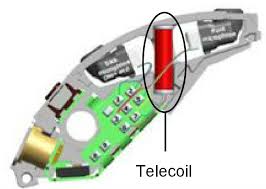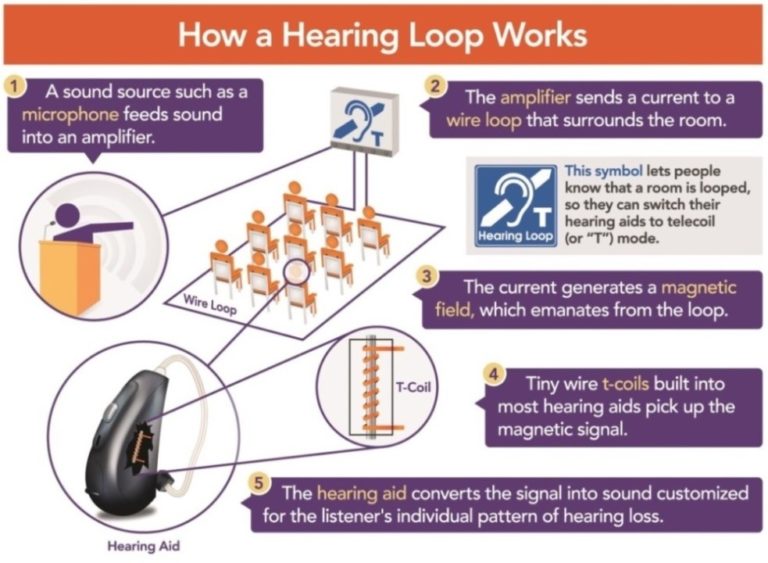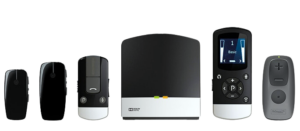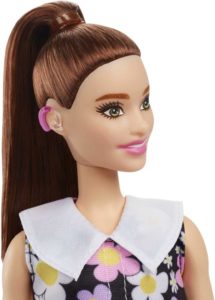What is a TeleCoil?
Did you know that your hearing aids have an antenna?...Sort of.
Telecoil, also called T-Coil, or T-Switch is a small wire coiled around a rod inside hearing aids. It functions as an antenna to pick up magnetic signals (usually transmitted by a loop or traditional telephone) and stream them as sound via hearing aids to your ears. Usage of a telecoil allows hearing aids to stream speaker’s voice or music directly into your ears, without any ambient background noise interference.

A telecoil is a small wire coil inside hearing aids. The coil works as a small receiver or antenna which picks up magnetic signals from a loop system that acts as an electromagnetic field. Hearing aids with an activated t-coil can convert this electromagnetic field into a sound signal.
Only the signal from the loop system’s is amplified, and background noise is shut out. If your hearing aid has a telecoil, you can activate it via the “t-coil switch” on your hearing aids.
Where can I use a telecoil system?

A telecoil can be used wherever a loop system is installed or with traditional house type telephones. When the t-coil function in a hearing aid is turned on, sound sent through the loop system or telephone is received by the hearing aid coil and amplified while ambient background noise is muted.
When used with the telephone, a t-coil provides a direct communication between a hearing aid and the telephone without interference from acoustic feedback or background noise.
The term “hearing aid compatible” refers to a telephone’s ability to inductively couple to a t-coil equipped hearing aid. But this technology is not just for telephones.
Due to the “Americans with Disabilities Act“, loop systems, aka “hearing loops” or “audio induction loops,” can be found in: Churches, Museums, Universities, Concert Halls, Taxi Cabs , Airports, Train Stations, etc.
Users of non-telecoil equipped hearing aids may have to remove their hearing aids prior to telephone usage.
Many behind-the-ear style hearing aids are manufactured with telecoils. Not all t-coils are created equal and can vary widely in sensitivity and performance even in similar hearing aids. Wearers should evaluate their performance equally with the overall acoustic performance.
Do I Need A TeleCoil?
This technology is one assistive listening feature for hearing aid wearers that can significantly improve sound clarity in one’s everyday life.
If you talk on the telephone often, strongly consider a hearing aid that has a t-coil. A t-coil equipped hearing aid will be of benefit for you.
Hearing aid compatible phones, whether a traditional telephone or a cell phone, are designed to produce a strong magnetic field for the coil to pick up. Instead of the hearing aid’s microphone receiving the sound, the coil picks it up.
When the magnetic signal is detected by the t-coil, it is then routed to the hearing aid amplifier. This system delivers higher quality sound to your ear that is easier to understand. The microphone on your hearing aid can be completely bypassed when using the -t-coil in a hearing aid.

Having a telecoil in your hearing aid ensures that you get the best experience when using telephones.
When using the hearing aid t-coil function, for optimum results, the hearing aid should be programmed so that when it is activated, the microphone is off, this configuration will provide the clearest possible signal from the telephone and will allow the user to adjust the volume of hearing aid for better hearing without picking up ambient background noise.
Automatic telecoils have become available on some hearing aids.
The T-coil detects magnetic energy and converts it to electrical energy. In the United States, the Telecommunications Industry Association‘s (TIA-1083) standard, specifies how analog handsets (telephones) interact with telecoil equipped devices, to ensure the optimal performance.
T-coils are effectively a wide-band receiver, although interference is unusual in most hearing loop situations. Interference can manifest itself as a buzzing sound, which varies in volume depending on the distance the wearer is from the source. Sources are electromagnetic fields, such as CRT computer monitors, older fluorescent lighting, some dimmer switches, many household electrical appliances and airplanes.
For more information on TeleCoils, please use the chat button, or email us at info@hearsource.com or call 1-800-416-2434.




